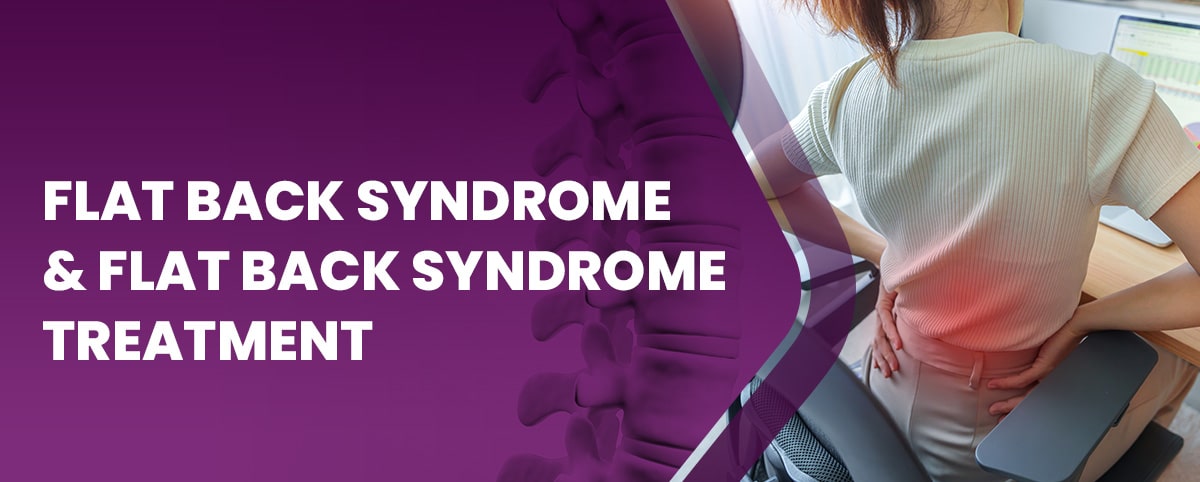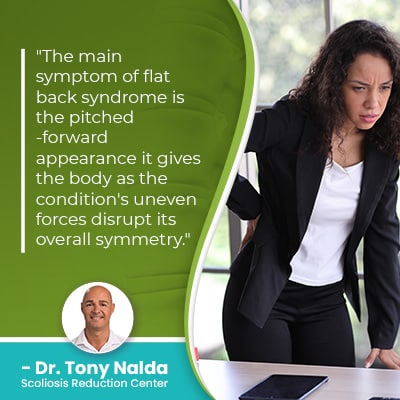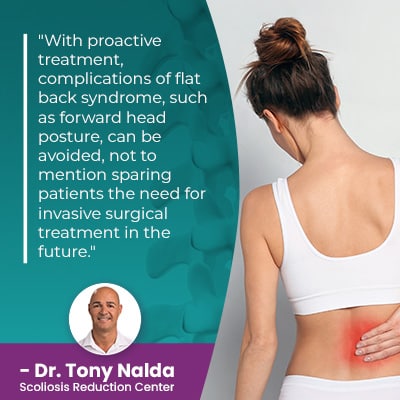Flat Back Syndrome & Flat Back Syndrome Treatment

The spine needs to maintain its natural curvature in each spinal section to keep the spine aligned, strong, flexible, and able to evenly support the body's weight and distribute mechanical stress.
A healthy spine curves at each of its main sections, and these curves impact how the spine functions. If the spine loses one or more of its natural and healthy curves, this disrupts spinal alignment and can cause the spine to become excessively straight, commonly referred to as flat back syndrome.
If the spine becomes excessively straight, its biomechanics are disrupted, and flat back syndrome treatment can include a number of disciplines.
Table of Contents
Healthy Spinal Curvatures
There's a reason for the spine's S-shape when viewed from the sides, and that's due to its natural curves at each spinal section.
The three main sections of the spine include the cervical spine (neck), thoracic spine (middle/upper back), and the lumbar spine (lower back).
Each of the sections has its own curvature type, and the health of each curve will depend on the health of the others, so if one healthy curve is lost, the spine responds by putting in bad curves, or developing a compensatory curve to counteract the first unhealthy curve's uneven forces, and/or the spine can become excessively straight.
The spine's natural curves either bend outwards, away from the body's center in a reverse 'C' shape, or inwards, towards the body's center in a standard 'C' shape.
Kyphosis and Lordosis
The spine's curvature sizes are measured in degrees, and while there is a natural range of curvature size that can vary from person to person, those curves still have to fall within a normal range to balance each other out.
Kyphosis refers to the outwards curve of the thoracic spine, and lordosis is found in the spine's inward curve at the cervical spine and lumbar spinal sections.
A healthy range of lordosis in the cervical spine ranges from 20 to 40 degrees, and an average range of lumbar lordosis falls within a range of 40 to 60 degrees
The thoracic spine should have a kyphotic range of between 20 and to 40 degrees.
When the spine's kyphosis, lordosis, or both don't fall within a healthy range, problems occur, and when the spine becomes excessively straight (flat), it's no longer as healthy, flexible, strong, and functional.
What is Flat Back Syndrome?
So what happens if the spine's natural level of lordosis or kyphosis becomes problematic: flat back syndrome can develop.
Flat back syndrome is diagnosed if the spine is too straight, and as mentioned, in order for the spine to function optimally, it has to maintain its healthy curves and alignment.
Symptoms of Flatback Syndrome
 The main symptom of flat back syndrome is the pitched-forward appearance it gives the body as the condition's uneven forces disrupt its overall symmetry.
The main symptom of flat back syndrome is the pitched-forward appearance it gives the body as the condition's uneven forces disrupt its overall symmetry.
Symptoms of flatback syndrome can also vary from person to person, but in addition the body's stooped-forward appearance, some common symptoms include:
- Painful back muscles
- Excessive fatigue
- Reduced mobility
- The sensation of falling forward (using a cane or walker can help provide additional support during motion)
- The stoop getting worse throughout the day and/or during long periods of standing
- Difficulty standing upright and maintaining healthy posture
A straight spine means the body is off center as its center of gravity is disrupted, meaning the body's weight isn't evenly distributed over the pelvis and legs.
As it's not just the spine that has to work to maintain its natural curves and alignment, but also its core and surrounding muscles, this is why the muscles of the back can become strained as they struggle to support the unnatural straightening of the spine.
Excessive levels of fatigue is a common symptom of a number of spinal conditions that involves a loss of its healthy curves, and this is because with a spinal imbalance comes changes to posture and gait; an uneconomical gait means it takes extra energy to try and counteract the unbalanced spine, causing fatigue.
Now, another issue that can develop if flat back syndrome is left untreated and/or becomes severe is what's known as forward head posture.
What's Forward Head Posture?
The body does its best to maintain its balance and healthy posture by counteracting uneven forces, and in some cases, the spine's effort to counteract the loss of a healthy curve can cause additional problems, such as the development of forward head posture.
In the body's attempt to counteract the straight spine, it can shift the head and neck forward, and this can lead to strained and sore upper-back muscles, painful shoulders, a sore neck, and tension headaches.
If the head shifts forward even as little as an inch, the weight of the head on the cervical spine increases by approximately 10 pounds, which is significant.
The cervical spine is the bridge between the brain and the rest of the body, so forward head posture can not only cause muscle fatigue, headaches, and mild to chronic pain, it can also disrupt brain-body communication.
If left untreated, forward head posture can cause a muscle imbalance in the neck, meaning the cervical spine isn't being supported or stabilized by its surrounding muscles.
So as you can see, even if the spine loses a single healthy curve, its effects aren't isolated to that one area of the spine, but can be felt in the other spinal sections, not to mention other areas of the body.
So now that we have defined flat back syndrome and some of the complications that can develop if left untreated, let's talk about treatment options.
Flat Back Syndrome Treatment
When it comes to spinal conditions developing, responding with proactive treatment is key.
Remember, even if a spinal condition isn't progressive, the spine is subject to natural age-related degeneration, such as in degenerative disc disease, that can cause issues such as flat back syndrome to become more severe.
While treatment success can never be guaranteed, a proactive conservative chiropractic-centered treatment approach can help address areas of vertebral subluxation and work towards realigning the spine and restoring its healthy curves.
 With proactive treatment, complications of flat back syndrome, such as forward head posture, can be avoided, not to mention sparing patients the need for invasive surgical treatment in the future.
With proactive treatment, complications of flat back syndrome, such as forward head posture, can be avoided, not to mention sparing patients the need for invasive surgical treatment in the future.
Here at the Scoliosis Reduction Center, I approach flat back syndrome treatment by integrating a number of different forms of condition-specific treatment so the condition can be impacted on every level for long-term sustainable treatment results.
Treatment plans can include chiropractic care, physical therapy, corrective bracing, when needed, and rehabilitation.
I offer my patients proactive nonsurgical treatments so they can avoid the risks, side effects, and potential complications of surgical correction.
Chiropractic Care
When chiropractic care is condition-specific, it can address structural problems such as an excessively-straight spine.
Through a number of chiropractic techniques and manual adjustments, I can work towards adjusting the straightest and most-problematic vertebrae (bones of the spine) back into a healthier alignment with the rest of the spine and restoring as much of its healthy curves as possible.
Physical Therapy
With the help of physical therapy and a number of specific exercises, I can help patients increase their core strength, which means the spine is optimally supported, and this also includes postural techniques to improve posture and body position.
Many patients find therapeutic exercise very beneficial when it comes to reversing some of the related muscle imbalances that can affect the lower back, hamstrings, and abdominal muscles.
While each patient needs a fully-customized treatment plan that includes the prescription of specific exercises to address key patient/condition variables, some common strengthening exercises I recommend include chin-ups, back extensions, chest stretches, abdominal stretches, side-lying leg raises, planking, and hamstring stretches.
Corrective Bracing
Corrective bracing can be an important facet of treatment for a number of spinal conditions, flat back syndrome included, and is particularly effective on growing spines.
A corrective brace can augment treatment results achieved through other treatment disciplines by pushing the spine into a corrective position, while supporting it and stabilizing it, as strong muscles do.
Rehabilitation
Rehabilitating the spine is key to maintaining long-term treatment success, and this can be accomplished through the prescription of customized exercises to establish a home-rehabilitation program.
These exercises can help keep the spine's supportive muscles strong, as well as the spine strong, provide pain relief, and work towards further stabilizing the spine.
If severe pain is an issue, being proactive with treatment can help address pain caused by the disruption to the spine's natural curves and spinal instability.
Conclusion
In order to fix flatback syndrome and avoid developing further related spinal issues, an abnormal curvature of the spine, and an excessively-straight spine, has to be treated proactively.
A physical examination coupled with x ray imaging can tell me exactly what is happening in and around the spine, and from this information, I can craft effective and customized treatment plans that work towards restoring the spine's natural curves and alignment.
A spine that's flat is going to make the body lean forward, particularly with a loss of lumbar lordosis, as the upper back becomes increasingly stooped as a compensatory response to when the lower spine loses its natural curve.
Here at the Center, I apply a number of chiropractic techniques, including spinal manipulation, and other forms of treatment such as physical therapy, corrective bracing, and rehabilitative exercises to address related symptoms that flatback syndrome present.
Dr. Tony Nalda
DOCTOR OF CHIROPRACTIC
After receiving an undergraduate degree in psychology and his Doctorate of Chiropractic from Life University, Dr. Nalda settled in Celebration, Florida and proceeded to build one of Central Florida’s most successful chiropractic clinics.
His experience with patients suffering from scoliosis, and the confusion and frustration they faced, led him to seek a specialty in scoliosis care. In 2006 he completed his Intensive Care Certification from CLEAR Institute, a leading scoliosis educational and certification center.
About Dr. Tony Nalda
 Ready to explore scoliosis treatment? Contact Us Now
Ready to explore scoliosis treatment? Contact Us Now





